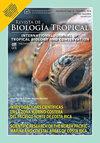Flowering time and harvest on floral morphology and production of hermaphrodite flowers in the cashew tree Anacardium occidentale (Anacardiaceae)
IF 0.6
4区 生物学
Q4 BIOLOGY
引用次数: 0
Abstract
Introduction: Morphological parameters of flowering are fundamental in the reproductive process of plants, but this subject is poorly explored in the cashew tree Anacardium occidentale. Objective: To determine the influence of the flowering and harvest period on floral parameters, and to identify association with hermaphrodite flowers in the dwarf cashew. Methods: For the 2018 and 2019 harvests in 120 samples we measured number of male/hermaphrodite/abnormal flowers; panicle biomass, length, maximum width, and ramifications at 30, 45 and 60 days for 360 samples in total, for each season (2018 and 2019). Results: The harvest effect was not significant. Panicle length and width (at 30 days), had the greatest contributions to the production of hermaphrodite flowers. The presence of male flowers (at 45 days), and the panicle length and number of primary branches (at 60 days) were the main factors at their respective periods. Conclusions: The emission of hermaphrodite flowers responds negatively to male flowers. Variations in flowering compromise the production of hermaphrodite flowers and the flowering structure.西方腰果科腰果花形态及雌雄同体花产量的花期与收获
开花形态参数是植物生殖过程的基础,但在腰果树(Anacardium occidentale)上研究较少。目的:研究开花期和采收期对矮腰果花学参数的影响,并鉴定其与雌雄同体花的关联。方法:在2018年和2019年收获的120个样品中,测量了雄性/雌雄同体/异常花的数量;每个季节(2018年和2019年)360个样品在30、45和60天的穗生物量、长度、最大宽度和分枝。结果:收获效果不显著。穗长和穗宽(30天)对雌雄同体花的产生贡献最大。雄花的出现(45 d)、穗长和一次枝数(60 d)是各时期的主要影响因素。结论:雌雄同体花的释放对雄花负响应。开花的变化损害了雌雄同体花的产生和开花结构。
本文章由计算机程序翻译,如有差异,请以英文原文为准。
求助全文
约1分钟内获得全文
求助全文
来源期刊

Revista De Biologia Tropical
生物-生物学
CiteScore
1.80
自引率
0.00%
发文量
23
审稿时长
4-8 weeks
期刊介绍:
The Revista de Biología Tropical / International Journal of Tropical Biology and Conservation is a mainstream scientific journal published since 1953 and covered by Web of Science; Science Citation Index; Current Contents; Google Scholar; Scopus, SciELO and nearly 50 additional indices.
A double blind system guarantees you a fair evaluation, and our world class editorial and scientific boards provides a first decision in three working days. The journal is Full Open Access and is widely read where your article can have the highest real impact.
Since its beginning in 1953, the Revista follows these principles: objective and independent evaluation of all manuscripts; transparency in all processes; ethical use of procedures, data, specimens and subjects; fair treatment of all parties; and absolute predominance of scientific rigor over any other aspect.
 求助内容:
求助内容: 应助结果提醒方式:
应助结果提醒方式:


